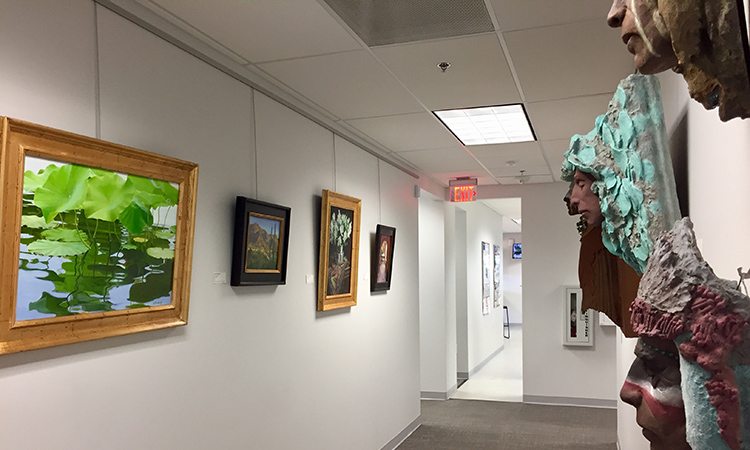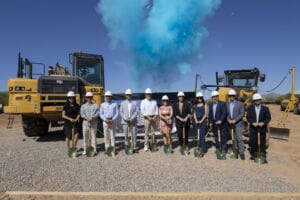Inside the glass-paneled windows, of MRA Associates’ offices at the Biltmore Financial Center it looks like an art gallery – framed paintings hang against a bright green wall and stand next to ornate sculptures.
Fluorescently lighted, white-walled office spaces are officially a thing of the past for modern companies. Employers are increasingly focusing on the aesthetics of their workspaces, and the message their space sends to employees and clients.
Christina Burroughs, the managing partner at MRA Associates, says that even at a company focused on finances, the creative energy fostered by the artwork helps engage employees and enhance collaboration. They’re also supporting local artists in a struggling industry.
“We’re a kind of business that does really well by interacting with one another,” she said. “We get things done quickly, solve problems, and come up with great new ideas if we’re interacting with each other.”
She recalls the day the installation went up and an obvious change of pace in the workspace.
“There was a buzz in this office, people saying ‘I love this piece!’ ‘Come look at this one’ ‘I want that,’” she said. “There really is an energy about having engaging, beautiful challenging things on our walls.”
MRA Associates’ current art installation features work from local women artists, voted on by a committee of rotating employees. They work with the Southern Arizona Arts and Culture Association (SAACA), a nonprofit intermediary that helps connect the artists with the office and provide the style of art the committee is looking for.
The whole idea of using their space as an art gallery is mutually beneficial.
The intermediary they work with takes about 10 percent commission for the artwork sold, a far cry from the 50 to 60 percent galleries typically receive.
Jane Barton, one of the artists whose work is featured in MRA Associates’ current gallery, says what it’s doing is a great alternative to the current decline in the art gallery business.
“Because of the economic climate and the Internet, [galleries] are struggling to keep artists and stay viable in business,” she said.
“I think places like MRA could be a very big part of the art sales segment in the future because it’s a win-win situation,” she said. “MRA or any other corporation gets great art for their walls, they have these receptions where they can possibly make some new contacts and they’re supporting the arts community.”
Unfortunately, not every office has the resources to do so.
“Investing in the hanging system is a big deal, it’s not cheap,” she said. “And also having the right space. Not everybody can do that.”
For years, coffee shops, beauty salons and other small businesses have been hanging local artwork to show support and enhance their environment. Other businesses like MRA Associates, or increasingly airports with their captive audiences, are taking on this role, Barton says.
“When we had our first show, we had a number of friends from the community, some represent business or law firms, and they were very interested in this and wanted to be introduced to SAACA to see if their office might be able to do something similar in their space” Burroughs says. “I think there’s going to be more of this.”
MRA Associates is new to the game, with its current installation being its second so far after an office renovation which allowed it to do so. It’s hard to say exactly who buyers may be, Burroughs says.
“Right now, we anticipate buyers being members of the community who are invited in, clients, we even have some employees watching for some particular pieces and sizes of pieces they might eventually like to collect,” she says.
“We also really want to support the arts community. Enabling our space to be showroom space for artists to get their work up and seen by the community… we always cheer when a piece sells. We think it’s a really excellent way to be engaged with our community, and our business serves our community.”
Using office space for art galleries is one way to enrich a work environment and send a message about your company. But some bigger corporations are homing in on the latter, seeing blank walls as an opportune way to promote their brand.
Gensler, a national architecture firm with an office in downtown Phoenix, designed online marketplace Etsy’s corporate office in New York, which features unique handmade artwork and furniture from the artisans featured on its website.
“Art is a meaningful expression that helps communicate (a company’s) values back to their employees,” says Melissa Holm, interior design director for the Phoenix Gensler office.
Interactive artwork such as Instagram headquarter’s “instagrammable” photo-op spaces and LinkedIn’s picture-book wall employees can draw on, both designed by Gensler, are another way to engage employees, Holm said.
“People really see the benefits of having their employees connect with the organization and space they’re in,” she said. “It’s a lot about engagement when you provide meaningful art.”
A trend towards wellness is also fueling more creative workplaces, she said.
“People are spending so much time in the office environment, more than it even was 10, 20 years ago,” Holm said.
“While we want to promote views to the outdoors and bringing nature in, art is kind of a way to do that and give people moments of peacefulness, something to relate to and look at.”
But ultimately, and across all industries, office culture is shifting, she said.
“10 years ago, corporate environments were very bland for a reason, not wanting to be offensive or overpower people and it’s really changed,” she said.
“It’s just about engaging people in the workplace, where before it might’ve been seen as a distraction. Now it’s seen as a measure of engagement and interest and something to talk about.”





